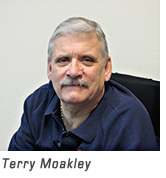 Each year, during October, the U.S. Department of Labor focuses on National Disability Employment Awareness Month. On their website, they provide an idea for some type of event or action that businesses or individuals might provide to help persons with disabilities find a decent job. One of those 31 daily “action” topics is simply “share what you did.”
Each year, during October, the U.S. Department of Labor focuses on National Disability Employment Awareness Month. On their website, they provide an idea for some type of event or action that businesses or individuals might provide to help persons with disabilities find a decent job. One of those 31 daily “action” topics is simply “share what you did.”
After sustaining a non-combat related spinal cord injury while in the Marine Corps way back in 1967, I was asked by the nurse in charge of my VA Hospital unit to serve as our ward’s patient representative. I said yes but it was an easy “job” because while the hospital was old and the food was terrible, I didn’t get many patient complaints.
My first real paying job was with this organization between 1972 and 1974, finding wheelchair-accessible apartments or owners of such units who were willing to let us renovate them so they could be lived in by vets with spinal cord injuries. Most of the time it was frustrating work because few apartment owners wanted their places altered. But I found real joy seeing the happiness on the faces of veterans once they were moved into their new homes.
Then for just one year, I found a part-time teaching job at a community college near where I lived. It was a five minute commute but the pay was insulting. Early on, I was asked to be the faculty moderator of the disabled students group, the Challengers Club. I agreed to do so, and it turned out to be very rewarding, too, helping younger persons with disabilities learn to “fit in” not just at school but in our society.
After leaving the college job, in mid-1976 I was offered a full-time position by a former CEO of this organization, and it turned into a 32 year career. During that time period, I worked on issues like wheelchair-accessible building design, accessible public transportation and even for a short time on improved access to air travel.
I became a program director for a 12 year block of time, and then an Associate Executive Director for some 17 years, during which I supervised our Communications and Public Affairs, aka Publicity, departments. A good friend of mine who worked in the business world down on Wall Street once told me that my position during those 17 years was equivalent to being a corporate Vice-president, maybe even a Senior Vice-president. That’s nice, but it didn’t matter much to me.
During my working years I learned that I could be a leader, but I also learned that there is strength in numbers. Whether you are a leader or a part of the team, let them know what you can do.
It has been said many times, “a picture is worth a thousand words.” When you go on those job interviews, show them what you can do by giving them a verbal “picture” of what you have done. Describe your employment history, including your military service, in terms of all your successful endeavors. And don’t be afraid to elaborate. Sing the praises of your previous work, and just maybe that upcoming interview will bring you the job of your lifetime.
Terry Moakley
Chair of the VetsFirst Committee
VetsFirst’s knowledge book, “Disabled Veterans Employment and Education: Gearing Up for Your Future,” provides essential resources to disabled veterans who are searching for employment or considering additional education. This online guide encourages veterans with disabilities to begin to seek out answers, ask more questions, and make informed decision that will ultimately lead to success in the workplace.
